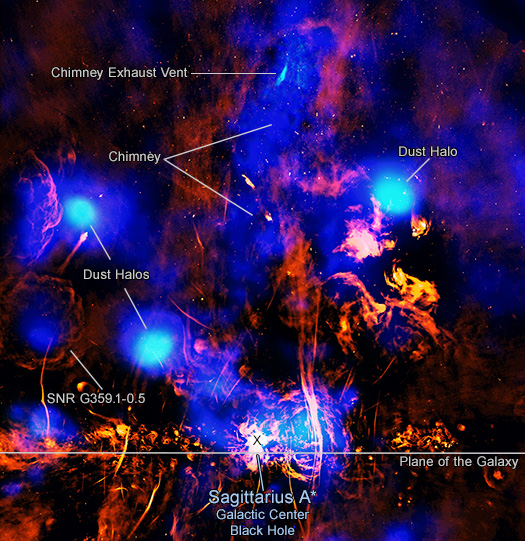
 Credit: X-ray: NASA/CXC/Univ. of Chicago/S.C. Mackey et al.; Radio: NRF/SARAO/MeerKAT; Image Processing: NASA/CXC/SAO/N. Wolk
Credit: X-ray: NASA/CXC/Univ. of Chicago/S.C. Mackey et al.; Radio: NRF/SARAO/MeerKAT; Image Processing: NASA/CXC/SAO/N. Wolk
Exhausting
The center of the Milky Way is surrounded, top and bottom, by large hot "bubbles" of ionized gas almost as big as the Galaxy itself, extending off the plane of the Milky Way into circumgalactic space. These bubbles could be powered by the combined effects of stellar winds from clusters of massive stars near the center of the Galaxy, or a sequence of supernovae, or perhaps even a past outburst of the Milky Way's now-dormant supermassive black hole, Sgr A*. A long X-ray observation near the Milky Way's central inner bulge by the Chandra X-ray Observtory provides scientists with important clues on how these extraordinary bubbles may have been blown. The image above shows a composite X-ray image from Chandra (in blue) and a radio image (in red) of the center of the Galaxy, a region known as the "Intermediate Bulge Deep Field" (or IBDF for short). As the labels in the image show, some of the X-rays define a type of cylindrical "chimney" pointing from near Sgr A* nearly perpendicular to the plane of the Galaxy, with an "exhaust vent" near the top of the chimney. X-ray emission from supernovae and scattered by dust clouds can also be seen in this complicated region. Astronomers believe the "chimney" was probably produced by intermittent ancient outbursts from Sgr A*, perhaps when the supermassive black hole swallowed a star that wandered too close to the black hole's event horizon. Similar outbursts, known as "tidal disruption events", have been seen from supermassive black holes in other Galaxies.
Published: June 3, 2024
<
HEA Dictionary ● Archive
● Search HEAPOW
● Other Languages
● HEAPOW on Facebook
● Download all Images
● Education ● HEAD
>

Each week the HEASARC
brings you new, exciting and beautiful images from X-ray and Gamma ray
astronomy. Check back each week and be sure to check out the HEAPOW archive!
Page Author: Dr. Michael F. Corcoran
Last modified Monday, 10-Jun-2024 14:53:53 EDT


